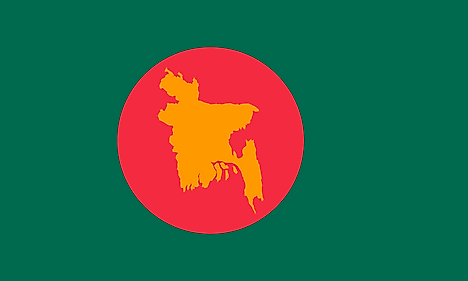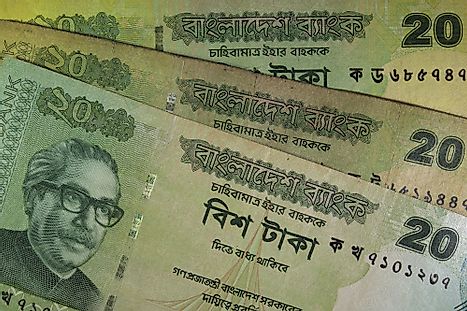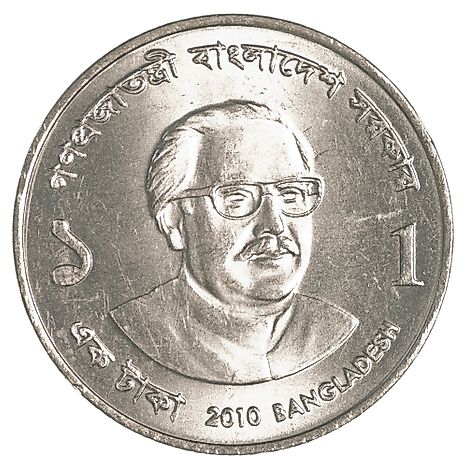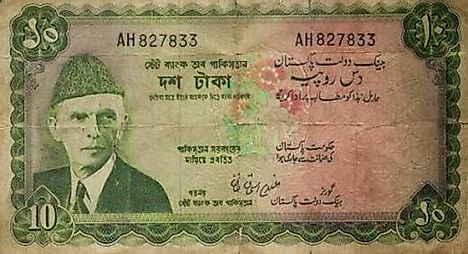Flags, Symbols & Currency of Bangladesh
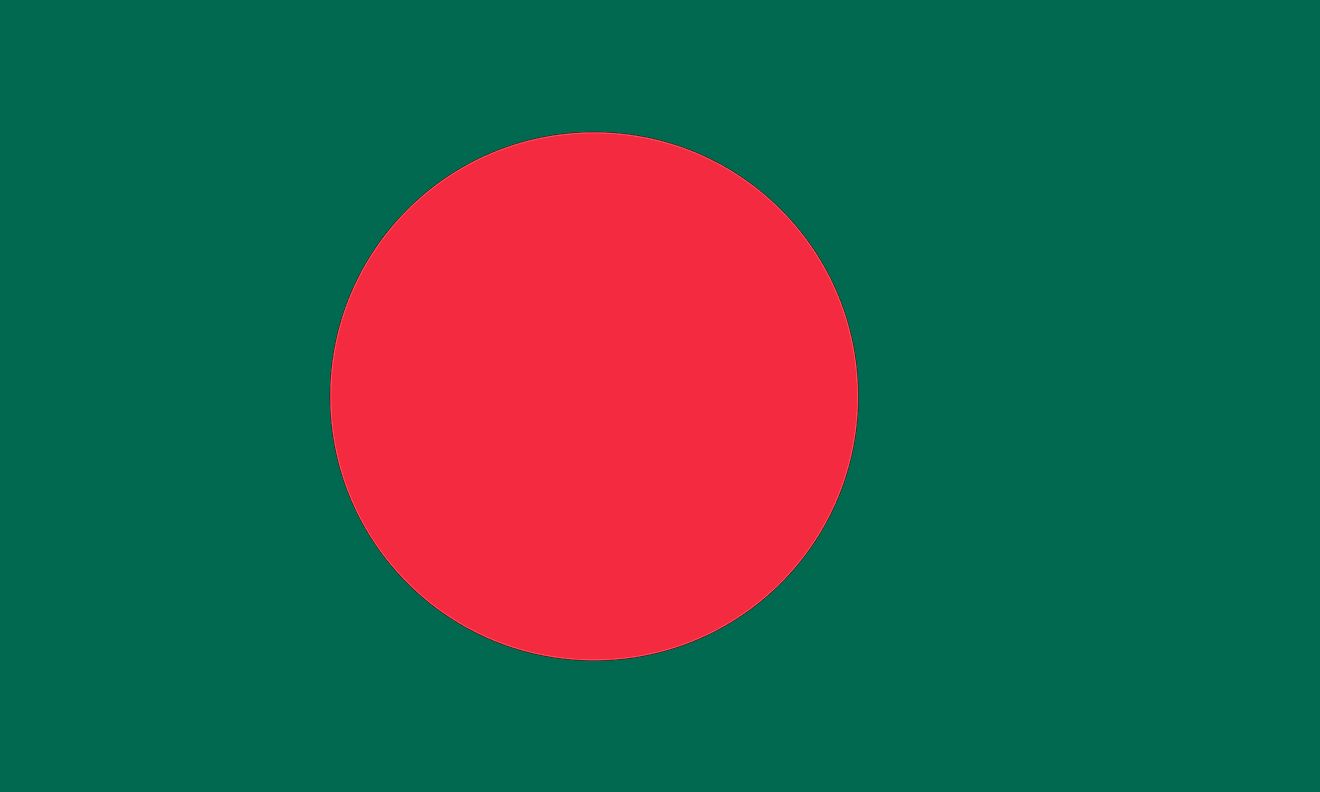
The People’s Republic of Bangladesh officially adopted its national flag on January 17, 1972. The design of the Bangladeshi national flag is based on a similar flag used during the Bangladesh Liberation War of 1971, which was designed by Quamrul Hassan.
The flag features a bottle green colored field with a large red disk shifted slightly towards the hoist. The bottle green color symbolizes the lush vegetation of the land of Bangladesh; while the red disk stands for the sun rising over the Asian region of Bengal. It also represents the bloodshed by the Bengalis in the Bangladesh Liberation War and hence serves as a socialist symbol showing the sun of independence rising after the dark fights against Pakistan.
History of the Bangladesh Flag
The first flag was designed on June 6, 1970, by the activists and some student leaders of the Swadhin Bangal Biplobi Parishad (a student movement council) at Dhaka University. This flag was green in color with a red disc, which had the map of Bangladesh, then known as East Pakistan, in gold at its center. The then Vice President of Dhaka University Students’ Union (DUCSU) A.S.M Abdur Rab, was the first to hoist the flag in Bangladesh at Dhaka University on March 2, 1971. The creation of the flag sought to remove the symbols of West Pakistan, which were the star and crescent. Freedom fighters fought under this original flag in the country’s War of Independence that began on March 26 and ended on December 16, 1971. Another historical flag used between March and December 1971 was the flag of Mukti Bahiti, a guerilla resistance movement. It was red with a white disc at the center showing a rifle-bayonet held by a hand. In 1972, the yellow map of the country was removed from the flag.
Symbols of Bangladesh
National Emblem of Bangladesh

The emblem of Bangladesh was adopted in 1971. It is composed of a water lily (Shapia: Nymphaea nouchali) in the center which is bordered with sheaves of rice/paddy on either side. Above the water lily are three connected jute leaves with two stars on each side. The water lily stands for the country’s national flower and represents many rivers that run throughout the country. The sheaves of rice symbolize the staple food of Bangladesh and the agricultural wealth of the nation. The four stars represent the four founding principles that are enshrined in the Constitution of Bangladesh: nationalism, secularism, socialism, and democracy.
National Animal - Royal Bengal Tiger
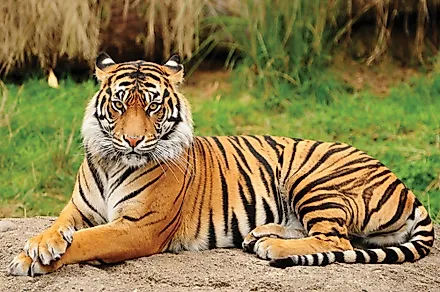
Royal Bengal Tiger (Panthera tigris tigris) is the national animal of Bangladesh. The tiger represents power, magnificence, and fearlessness. Tigers are found in the forests of Sundarbans and the Chittagong Hill tracts. The members of the Bangladesh Army and East Bengal Regiment are nicknamed “Bengal Tigers”.
National Anthem
- Anthem Title: “Amar Sonar Bangla” (আমার সোনার বাংলা)
- Music composer: Gagan Harkara (modern instrumental arranged by Samar Das)
- Lyricist: Rabindranath Tagore
- Date of Adoption: 1971
The national anthem of Bangladesh is “Amar Sonar Bangla” /আমার সোনার বাংলা. The lyrics were written by Nobel Laureate Rabindranath Tagore in 1905. The music of the song was adapted from the Baul song, “Ami Kothay Pabo Tare” by composer Gagan Harkara. The modern instrumental version of the song was arranged by Samar Das. The song was officially adopted as the National Anthem of Bangladesh in 1971. Only the 1st 10 lines currently constitute the national anthem.
আমার সোনার বাংলা (Bengali)
আমার সোনার বাংলা, আমি তোমায় ভালোবাসি।
চিরদিন তোমার আকাশ, তোমার বাতাস, আমার প্রাণে বাজায় বাঁশি॥
ও মা, ফাগুনে তোর আমের বনে ঘ্রাণে পাগল করে,
মরি হায়, হায় রে—
ও মা, অঘ্রাণে তোর ভরা ক্ষেতে আমি কী দেখেছি মধুর হাসি॥
কী শোভা, কী ছায়া গো, কী স্নেহ, কী মায়া গো—
কী আঁচল বিছায়েছ বটের মূলে, নদীর কূলে কূলে।
মা, তোর মুখের বাণী আমার কানে লাগে সুধার মতো,
মরি হায়, হায় রে—
মা, তোর বদনখানি মলিন হলে, ও মা, আমি নয়নজলে ভাসি॥
My Golden Bengal
My golden Bengal, I love you.
Forever thy skies, thy air set my heart in tune as if it were a flute,
O mother! The aroma of the mango orchard in Falgun drives me crazy,
Ah, what a thrill!
O mother! In Ogrohayon time sees sweet smiles all through mature fields of paddy.
What beauty, what shades, what affection, what tenderness!
What a quilt hast thou spread at the feet of banyan trees and along the bank of every river,
Oh mother mine, words from thy lips are like nectar to my ears.Ah, what a thrill!'
If sadness, O mother! casts a gloom on your face, my eyes are filled with tears!
The Currency of Bangladesh is the Bangladeshi taka
The official currency of Bangladesh is the Bangladeshi taka (৳ or Tk; BDT). The currency is controlled by the country’s central bank, known as the Bangladesh Bank. Its operations are monitored by the Ministry of Finance.
Coins
The Bangladeshi taka is subdivided into 100 poisha. In 1973, coins in 5, 10, 25, and 50 poisha denominations were introduced into the Bangladeshi economy. The 1 poisha coin was introduced in 1974, while the ৳1 coin was minted in 1975. The coins were struck in either aluminum (1,5, and 10 poisha), steel (25 and 50 poisha), or copper-nickel (৳1 coin). Currently, the poisha is seldom used, and only the ৳1, ৳2, and ৳5 coins are regularly circulated.
Banknotes
Bangladeshi taka banknotes normally occur in denominations of ৳2, ৳5, ৳10, ৳20, ৳50, ৳100, ৳500, and ৳1000. However, the ৳1, ৳25, ৳40, and ৳60 notes are rarely used by Bengalis. The Security Printing Corporation Bangladesh Ltd. is responsible for printing taka banknotes.
Commemorative Banknotes
The first commemorative banknote ever minted in Bangladesh was the ৳40 introduced in 2011. It was minted to commemorate the “40th Victory Anniversary of Bangladesh.” The note features Bangabandhu Sheikh Mujibur Rahman, who is the Father of the Nation. It also has portraits of six armed men and the National Martyr’s Monument in Savar. The second note ৳60 was introduced on February 15, 2012, to celebrate Bangladesh’s “60 years of National Movement.” Then the ৳25 note was first minted on January 26, 2013, to commemorate the silver jubilee of the Security Printing Corporation. The latest commemorative currency was the ৳100, introduced to celebrate the 100th anniversary of the Bangladesh National Museum.
Historical Currencies of Bangladesh
After the Partition of Bengal in 1947, in East Pakistan, the Pakistani rupee bearing the word taka on official notes and coins was in use. Before the Liberation War of 1971, banknotes of the State Bank of Pakistan was used throughout the country and continued to be used until the official introduction of the Bangladeshi taka on March 4, 1972. The Bangladeshi taka became the legal tender after the Pakistani government withdrew the status of its 100- and 500-rupee banknotes as legal tender. This was done to prevent the high-denomination notes from negatively affecting the Pakistani economy. However, these denominations were also in circulation in Bangladesh. The first ৳1, ৳5, ৳10 and ৳100 were introduced in 1972, while ৳50, ৳500, ৳20, and ৳2 were introduced in 1975, 1977, 1980, and 1989, respectively.
